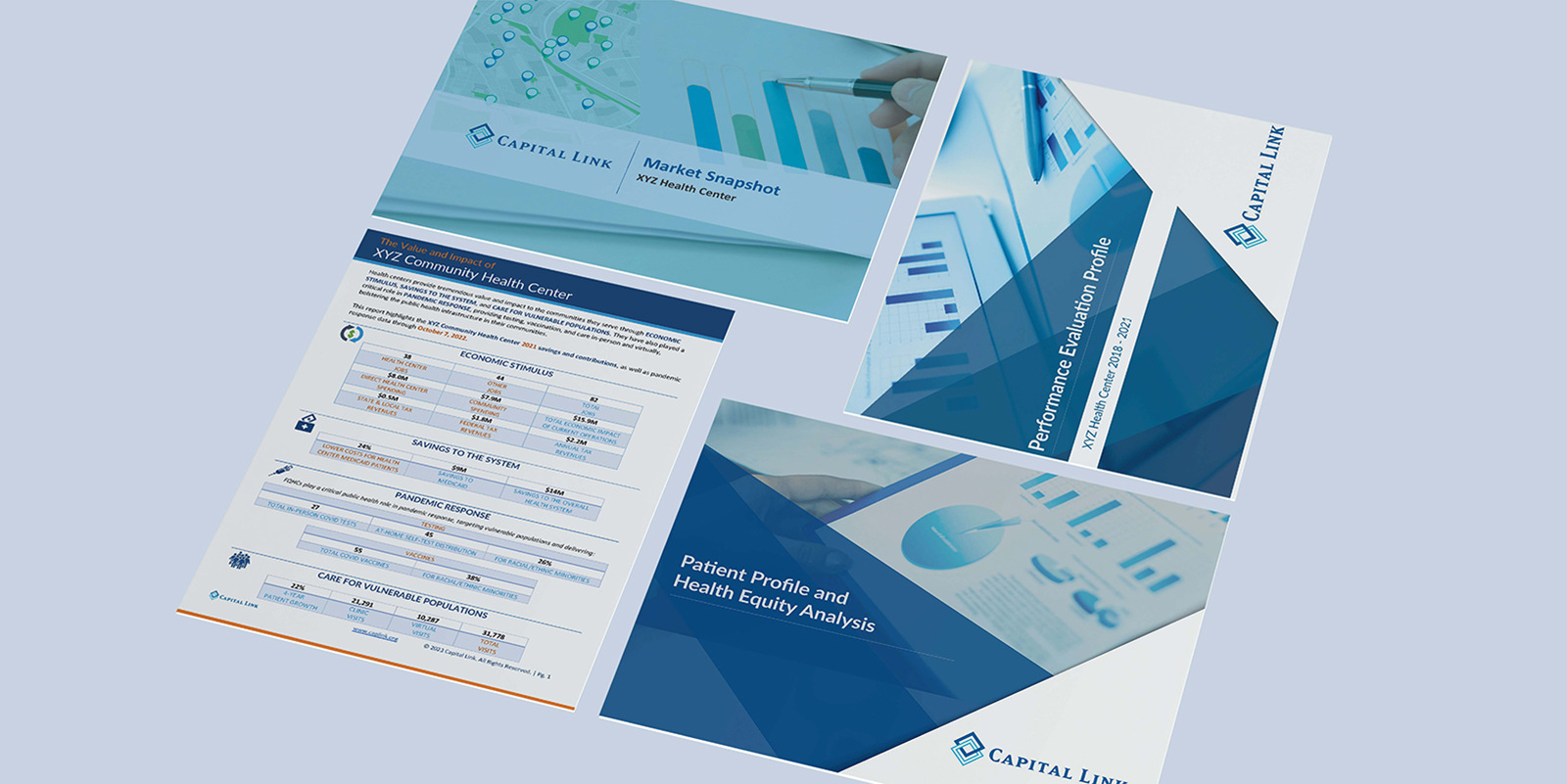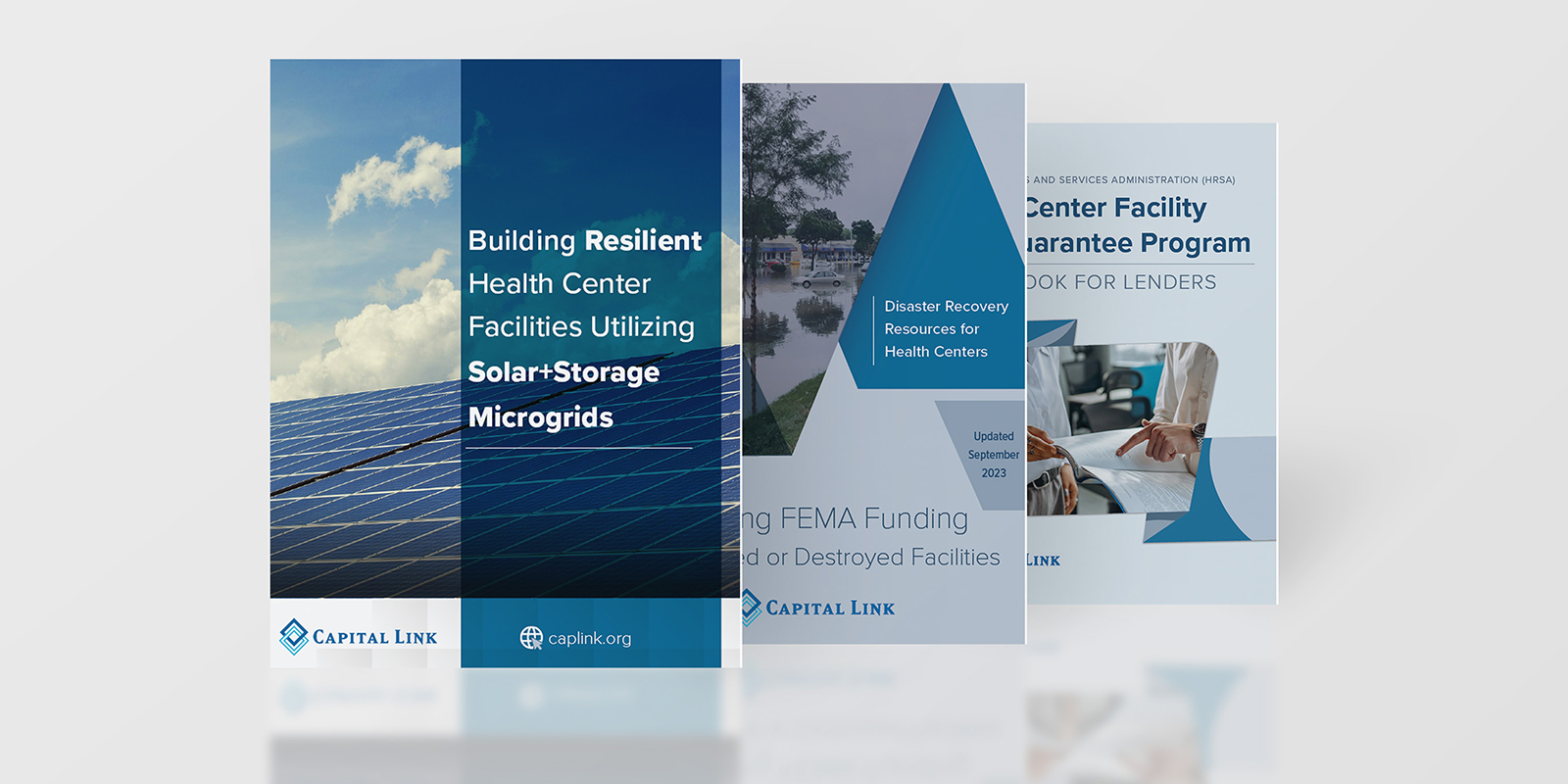Capital Link is committed to helping ensure that health centers are equipped to financially weather the impacts of this pandemic. Below is a collection of COVID-19 funding sources and financing-related resources and tools. We will continue to update this page as we obtain new information. To receive notifications on updates we make to this page, FOLLOW US ON TWITTER >
If you have questions, please contact Jonathan Chapman, Chief Project Officer, at This email address is being protected from spambots. You need JavaScript enabled to view it..
Jump to...
Funding Sources >
Trainings Related to COVID Response and Recovery >
Resources
National Capital Grants Infographic for FQHCs
Utilizing FY2021 American Rescue Plan – Health Center Construction and Capital Improvements (ARP-Capital, C8E) data, Capital Link prepared a National Capital Grants for FQHCs Value & Impact infographic to show the impact of the projects on their communities. Economic impact was measured using 2019 IMPLAN Online. VIEW REPORT >
National Report: Financial Impact of COVID-19 on FQHCs
Capital Link's new report provides a national picture of health center revenue loss, COVID-19-related expenses, the influx of relief funds through December 31, 2020, and the estimated funding gap, based on the 15-month period from April 2020 through June 2021. We also offer customized reports with statewide or regional analysis for PCA, HCCNs and Consortia, as well as reports for individual health centers. VIEW REPORT >
The Impact of COVID-19 on Health Center Revenue and Jobs: A 50-State Analysis
View a state-by-state estimate of health center revenue and job loss as a result of the COVID-19 pandemic. The analysis estimates the impact of a 50% decline in patient visits over a three-month period from April through June 2020, based on audited financial data HRSA Uniform Data System data, and economic impact multipliers. VIEW ANALYSIS >
CHC Finance Toolkit — COVID-19
NACHC and BKD have compiled guidance in critical areas in order for community health center leaders to guide their teams through difficult times and prepare them to come out stronger on the other side. Topics include cash flow planning, Cares Act guidance, and remote work best practices. VIEW TOOLKIT >
WEBINAR: Payroll Protection Program and Non-Traditional Financing for FQHCs during COVID-19
This NACHC and Capital Link webinar, held on April 27, 2020, discusses non-traditional financing opportunities for health centers dealing with financial downturn during COVID-19, focusing on the latest developments in the Paycheck Protection Program (PPP) administered by the Small Business Administration and tips for strengthening health center participation in the PPP. ACCESS RECORDING, SLIDES, AND Q&A >
Tool for Understanding and Complying with Federal Funding Streams for COVID-19
NACHC created this comprehensive, multi-tab spreadsheet to assist health centers in understanding, allocating, and complying with the range of Federal COVID-19 funding streams available. Additonal tabs will be added over time. VIEW SPREADSHEET >
Grants, Loans, and Other Cashflow Options for Health Centers, PCAs, and HCCNs
NACHC has provided an overview of funding resources that that health centers – as well as PCAs and HCCNs - may be able to access to cover revenue shortfalls and to help their employees make ends meet during this time. These resources are divided into grants from HHS, and non-grant options, which include loans, tax credits, advances, deferrals, paid employee leave, and unemployment insurance. VIEW DOCUMENT >
NACHC Financial Impact Fact Sheet for Health Centers
NACHC has created a fact sheet, utilizing Capital Link data, detailing the negative impact COVID-19 will have on health centers’ visits, revenue, and employment over six months and how Congress can help reduce the financial loss. VIEW FACT SHEET >
Coronavirus Emergency Loans Small Business Guide and Checklist
The U.S. Chamber of Commerce has issued this guide to help small businesses and self-employed individuals check eligibility and prepare to file for a loan. VIEW CHECKLIST >
Community Development Financing Sources for Health Centers
The Council of Development Finance Agencies (CDFA) COVID-19 Resource Center contains information on community development financing sources. The State Response Map features a list of state and local financing programs and related media headlines. LEARN MORE >
Searchable Databases
Funds for Coronavirus Relief by Location
Candid.org is compiling a list of funds specifically established in the wake of coronavirus, searchable by
geographic area. The list focuses on funds hosted at US-based foundations that serve nonprofits, though
others outside of this criteria may appear as well. VIEW LIST >
Funding Sources
FEMA Public Assistance Grants
On March 13, 2020, President Trump declared COVID-19 a national emergency. As a result of this declaration, state, territorial, tribal and local government entities and certain private nonprofit (PNP) organizations are eligible to apply for FEMA Public Assistance. The FEMA funding made available through the president’s emergency declaration is designed to reimburse qualified organizations for much of their emergency response costs. LEARN MORE > SUMMARY OF ELIGIBLE COSTS, ETC. > ACCESS FEMA PORTAL >
CARES Act (Cornonavirus Aid, Relief, and Economic Security Act)
The Coronavirus Aid, Relief, and Economic Security Act (CARES Act) (S. 748) provides $2 trillion for businesses, hospitals, schools, and social support programs, among many other things. LEARN MORE >
Employee Retention Credit - On March 2, 2021, the U.S. Department of the Treasury (Treasury) and IRS released Notice 2021-20 (Notice), providing guidance on the Employee Retention Credit (ERC) under the CARES Act. The ERC is a refundable payroll tax credit for employers whose operations were fully or partially suspended due to government orders or who experienced a significant decline in gross receipts due to the COVID-19 pandemic. LEARN MORE >
Funding opportunities for health centers under the CARES Act include:
HHS Announces Phase 4 and ARP Rural Distributions for Provider Funding
Learn more about how to attest to payments via the Provider Relief Fund Application and Attestation Portal HERE >
1. Provider Relief Fund - Phase 4
On December 16, 2021, HRSA will begin distributing approximately $9 billion in Provider Relief Fund (PRF) Phase 4 payments to health care providers who have experienced revenue losses and expenses related to the COVID-19 pandemic. The average payment being announced for small providers is $58,000, for medium providers is $289,000, and for large providers is $1.7 million. More than 69,000 providers in all 50 states, Washington, D.C., and eight territories will receive Phase 4 payments. Applicants receiving payments will receive an email notification with more information. READ PRESS RELEASE > LEARN MORE >
2. American Rescue Plan - Rural
On November 23, 2021, HRSA began distributing ARP Rural payments. LEARN MORE >
Small Business Administration Paycheck Protection Program (PPP)
As a part of the CARES Act, the Small Business Administration's (SBA's) Paycheck Protection Program (PPP) is a loan option to help prevent workers from losing their jobs and keep small businesses from going under due to economic losses caused by the COVID-19 pandemic. LEARN MORE > HEALTH CENTER PPP ASSESSMENT FINDINGS >
-
-
-
-
New Forgiveness Options & Appeals Deferment: By opting into the direct borrower forgiveness process, borrowers with loans under the maximum $150,000 will be able to submit the equivalent of Form 3508S in an online portal. Then their lender will be able to review the application and submit a decision for forgiveness to the SBA from within the online portal. REGISTER AND APPLY FOR FORGIVENESS >
-
On Jan 8, 2021, the SBA announced the reopening of the PPP for new and certain existing PPP borrowers. This round authorizes up to $284 billion toward job retention and certain other expenses through March 31, 2021 and by allowing certain existing borrower to apply for a Second Draw PPP Loan. READ PRESS RELEASE > SECOND DRAW INFO > TOP-LINE OVERVIEW >
-
-
-
FIRST DRAW INFO > FIND A LENDER > FIRST DRAW APPLICATION > FAQs >
LOAN FORGIVENESS INFO > LOAN FORGIVENESS APPLICATION FORMS >
-
-
-
- The SBA requires non-profit borrowers, such as health centers, that received a PPP loan of $2 million or greater and have applied for forgiveness to complete a Form 3510 Non-Profit Borrowers Questionnaire in order to solicit supplemental information regarding the necessity of the loan request within 10 days of receiving it from their lender. DOWNLOAD FORM 3510 > Since Form 3510 does not allow the opportunity for health center borrowers to provide context surrounding the situation that resulted in the loan necessity, Capital Link worked with NACHC to provide comments to the SBA on Form 3510 during the comment period. READ NACHC'S COMMENTS > and the SBA has since updated its FAQs. READ FAQs > You can find NACHC’s latest recommendations for health centers here: NACHC’s RECOMMENDATIONS >
-
-
-
-
-
-
A new eligibility category added for tangible net worth of not more than $15 million and average net income after federal taxes for the prior two full fiscal years is not more than $5 million; the existing affiliation rules would apply in computing the $5 million and $15 million thresholds. This would allow employers that do not meet the headcount numbers to possibly qualify, including health centers of more than 500 employees. LEARN MORE >
-
-
-
-
-
-
-
Capital Link developed a Stimulus Loan Calculator as a template for gathering the necessary SBA PPP application information. DOWNLOAD CALCULATOR >
-
NACHC Letter for Lenders - The PPP statute indicates that applicants like health centers should receive priority in the process and disbursement loans. However, some lenders may not be aware of this priority and health centers applying for PPP loans may want to consider alerting lenders themselves. NACHC sent a letter to the SBA outlining the language in the PPP law with the criteria for which borrowers get priority and the language from Section 330 that demonstrates that health centers meet these criteria. Send a copy of NACHC’s letter to your lender or use language from it to create your own letter to your lender. DOWNLOAD LETTER >
-
-
-
Federal Communications Commission COVID-19 Telehealth Program
Includes $200 million for nonprofit clinics and hospitals to fund telehealth access. On September 29, 2021, the FCC announced awards for Round 2 of the COVID-19 Telehealth Program. An additional 72 applications for funding commitments totaling $41,113,186 for Round 2 of its COVID-19 Telehealth Program. This is roughly two-thirds of the total funding available under Round 2; further awards are forthcoming. FCC COVID- TELEHEALTH PROGRAM PAGE > ROUND 2 FUNDING AWARDS PUBLIC NOTICE >
The CARES Act Economic Stabilization Fund
$500 billion has been designated to be used to retain employees and restore the compensation and benefit levels. Mid-sized nonprofits and businesses that have between 500 and 10,000 employees are expressly eligible for loans under this provision. Although there is no loan forgiveness provision in this section, the mid-size business loans would be charged an interest rate of no higher than two percent and would not accrue interest or require repayments for the first six months. Nonprofits accepting the mid-size business loans must retain at least 90 percent of their staff at full compensation and benefits until September 30th. LEARN MORE >
Small Business Administration Economic Injury Disaster Loans - The SBA has reopened its Economic Injury Disaster Loan program to ALL small businesses. The reopening comes more than a month after the SBA closed the program to new applicants except for agriculture-related companies.
The $484 billion COVID-19 3.5 relief package signed into law on April 24, 2020 included an appropriation for an additional $50 billion for SBA’s Disaster Loans Program Account and $10 billion for Emergency Economic Injury Disaster grants, while increasing the authorization level for the emergency economic grants from $10 billion to $20 billion. LEARN MORE >






